| |
|
Pictures on this page are copyright and may not be used without permission
|
|
These products support the work of the Waoranis to preserve their unique culture and their home: the rain forest. These can all be obtained by traveling to Ecuador and purchasing them directly from the Waorani. If you are not traveling to Ecuador soon, read below to learn how obtain some of these items in the U.S. .
|
|
Thanks again to our friend SUSAN KING and the Waorani
for these excellent descriptions |
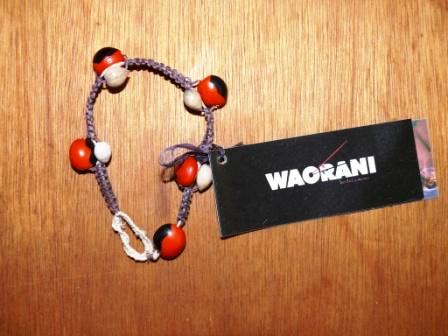 |
shigra « digindai » palm string bag
Uso tradicional : Para transportar todas sus pertenencias cuando se mudaban de un logar a otro y para acarrear lo que obtienen en la cacería o pesca, o bien los alimentos que recogen en el bosque.
Traditional use : Used to transport personal ítems when moving from one place to another. Also used to carry food gathered from the forest and while hunting and fishing.
« »
Elaboración : Usamos la palma de chambira , recogido de la selva, para la elaboración de shigras. Las hojas de la palmas están cocinadas, secadas en el sol, y después restregar entre las pierna y la palma de la mano para hacer el hilo. La fabricación de una shigra toma de tres a cinco días. Las mujeres Waorani conocen 15 diseños diferentes para tejer y elaborar shigras tradicionales y modelos nuevos incluido porta celulares.
Production : We use the chambira palm collected from the forest to weave our palm string bags. The palm leaves are cooked, dried in the sun, then rolled between the palm of the hand and thigh to make the string. Each bag can take three to five days to make. Waorani women know 15 different weaving designs and make traditional bags as well as new designs such as cell phone carriers.
|
|
| |
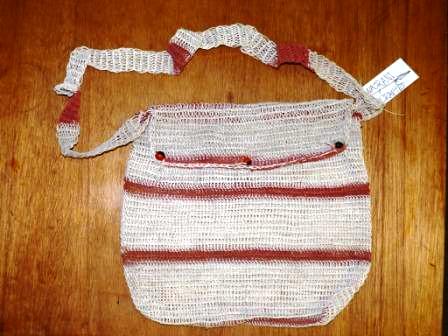 |
This page describes a wide variety of traditional objects made by the Waorani. Save America's Forests currently has a limited supply of some of the articles described illustrated on our Handicraft Samples page.
If you would like to obtain one of these handcrafts,
and help the efforts of the Waorani
to protect their Amazon forest,
contact:
Save America's Forests
202-544-9219 |
|
| |
 |
cerbatana « omena » blow gun
Uso tradicional : Las cerbatanas son parte integral e imprescindible de la cultura tradicional Waorani. Usamos las cerbatanas para cazar. Podemos matar monos o aves grandes que están ubicados hasta a 40 metros de altura. Tradicionalmente, usábamos dardos con veneno curare y para que el dardo tenga estabilidad en el momento de soplarlo, se envuelve un poco de algodón en su extremo posterior.
Traditional use : Blowguns are an integral and essential part of the traditional Waorani culture. We use the blow gun to hunt. Traditionally, we use poison tipped darts and are able to kill monkeys or large birds that are located up to 40 meters high in the trees. We wrap cotton around the end of the dart in order to stabilize it when blowing the darts.
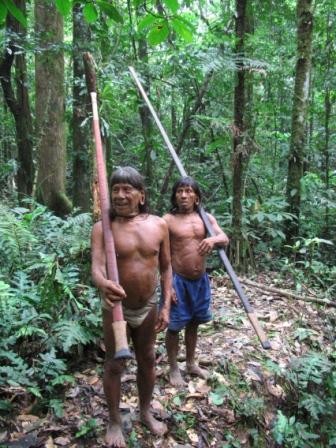
.Photo Matt Finer ©Save America's Forests
|
|
« »
Elaboración : Los hombres se encargan de la fabricación de las armas. La cerbatana esta formada por dos tiras gruesas de pambil de forma semi cilíndrica aplanada, envuelta en bejuco café. Junto con la cerbatana se utiliza un tubo de guadua en el cual se llevan los dardos.
Production : Waorani men are responsible for making all the weapons. The blowgun is made of two strips of thick pambil palmwood which are united to form a flat t ened tube and wrapped in a brown vine. The blowgun is paired with a guadua tube which holds the darts. |
|
| |
 |
peinilla « kewigade » comb
Uso tradicional : Antes del contacto con cowudi (los no Waorani) usábamos las peinillas tradicionales para peinar el cabello.
Traditional use : Before outside contact, we used handmade traditional combs to comb our hair.
« »
Elaboración : Usamos el mismo material que usamos para hacer dardos: birote (nampabi) y cortamos los palitos para hacer los dientes de la peinilla. Las mujeres Waorani adornan las peinillas con piolas de chambira y algodón tintados con diferentes colores.
Production : We use the same small sticks used in making darts to make the teeth of the comb. Women decorate the combs with chambira and cotton string dyed different colors.
|
|
| |
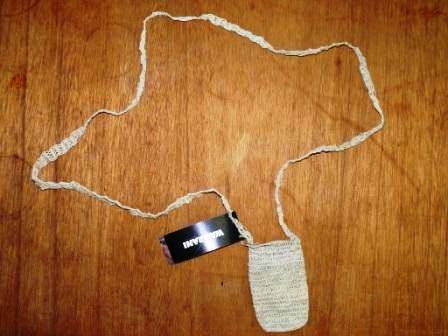 |
pasa cuerpo « onyemee » body cross
Uso tradicional : Antiguamente los hombres entregaban los pasa cuerpos a las esposas. Los diferentes colores eran importantes a las mujeres, especialmente el color rojo. Unos pasa cuerpos tenían significados especiales, por ejemplo algunos significaban que el pasa cuerpo fue entregado por un joven trabajador. Hoy día, nos ponemos los pasa cuerpos para las fiestas, desfiles y bailes.
« »
Traditional use : Historically, the men give the body cross to their wives. The different colors were important to the women, especially the color red. Some of the body crosses had specific meanings, for example some indicated that they were given by a young worker. Today we put on the body crosses for parties, parades and dances.
Elaboración : Usamos la palma chambira para hacer las piolas y después hacemos en una equis. La elaboración toma hasta un día.
Production : We use chambira palm which we twist into string and then wind it into an X. It can take up to a day to make a body cross. |
|
| |
|
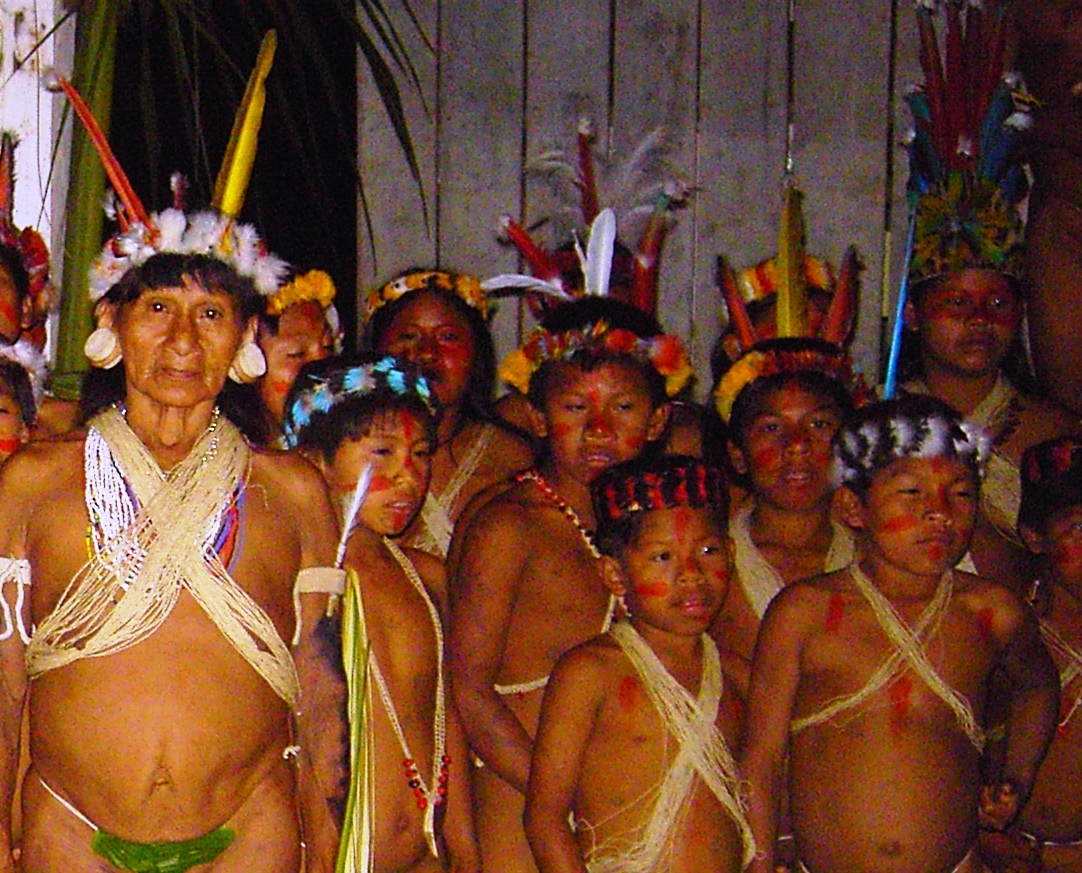
Waorani Woman and children wearing traditional decorations, including body cross, at ceremony and celebration in Waorani village of Bameno in Waorani Territory in Yasuní (photo ©Carl Ross, Save America's Forests)
|
|
| |
|
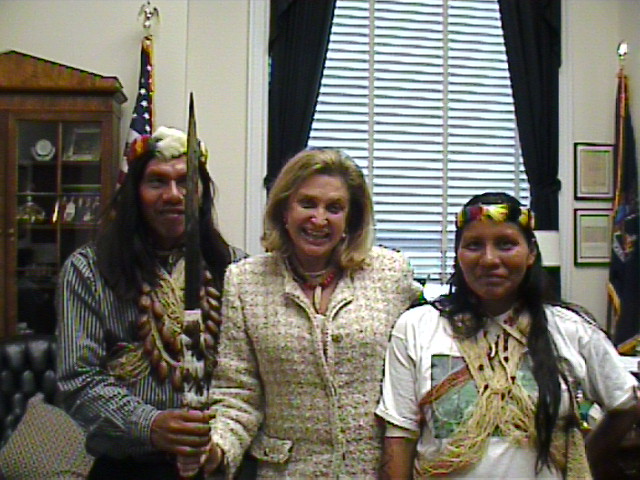 |
|
Waorani Leaders Moi Enomenga and Alicia Cahuiya Wearing Body Cross with U.S. Congressional Representative Carolyn Maloney in Washington DC Congressional Office (photo ©Carl Ross, Save America's Forests)
|
|
| |
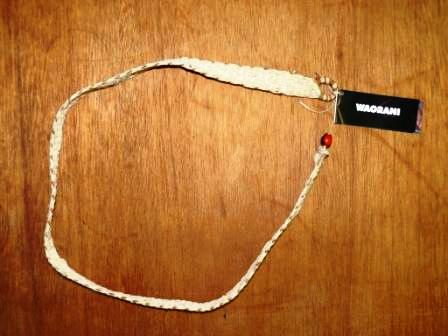 |
fogata « kakapa » fire starter
Uso tradicional : Antiguamente, usábamos la fogata para encender los fuegos por las noches y para cocinar en la selva. Para encender un fuego con una fogata, es importante que los palos estén bien secado. Primero ponemos un palo plano de achiote encima del algodón silvestre en el suelo. Luego, cogemos una raíz duro de yakewe (nombre en wao terero) y se pone vertical encima del palo de achiote. Con la raíz entre las dos manos, restregamos con mucha fuerza para que haga girar rápidamente hasta que encienda el fuego.
Traditional use : Historically we used materials from the forest in order to start fires at night and to cook by in the jungle. To light the fire, it is important that the sticks be very dry. First we put a flat achiote stick on top of wild cotton on the ground. Using a yakewe root , we place it vertically on top of the achiote stick, then spin it by rubbing our hands together until the fire starts.
« »
Elaboración : Hombres y mujeres elaboran las fogatas. Solo hay que buscar los materiales que son mas o menos comunes en la selva.
Production : Men and women make the firestarters from natural materials commonly found in the forest.
Uso tradicional : Antiguamente, usábamos la fogata para encender los fuegos por las noches y para cocinar en la selva. Para encender un fuego con una fogata, es importante que los palos estén bien secado. Primero ponemos un palo plano de achiote encima del algodón silvestre en el suelo. Luego, cogemos una raíz duro de yakewe (nombre en wao terero) y se pone vertical encima del palo de achiote. Con la raíz entre las dos manos, restregamos con mucha fuerza para que haga girar rápidamente hasta que encienda el fuego.
Traditional use : Historically we used materials from the forest in order to start fires at night and to cook by in the jungle. To light the fire, it is important that the sticks be very dry. First we put a flat achiote stick on top of wild cotton on the ground. Using a yakewe root , we place it vertically on top of the achiote stick, then spin it by rubbing our hands together until the fire starts.
« »
Elaboración : Hombres y mujeres elaboran las fogatas. Solo hay que buscar los materiales que son mas o menos comunes en la selva.
Production : Men and women make the firestarters from natural materials commonly found in the forest.
|
|
| |
 |
corteza del árbol « weuta » tree bark
Uso tradicional : Usamos la corteza del árbol huaba para elaborar faldas y cargadoras de niños.
Traditional use : We use tree bark to make skirts and baby carriers.
« »
Elaboración : Después de tumbar el árbol , cortamos la cáscara del árbol con machete y golpeamos con un palo o machete de chonta. Luego la bajamos la corteza y secamos. Lavamos la corteza en agua, y dejamos en el sol para secar por dos o tres días. Luego podemos usar la corteza como tela para elaborar faldas o cargadoras.
Production : After cutting the huaba tree, we cut the bark of the tree with a machete and pound it with a stick or a machete made of chonta wood. We then remove the bark, wash it in water and then let it dry in the sun for two to three days. We are then able to use the tree bark as material to make skirts or baby carriers.
|
|
| |
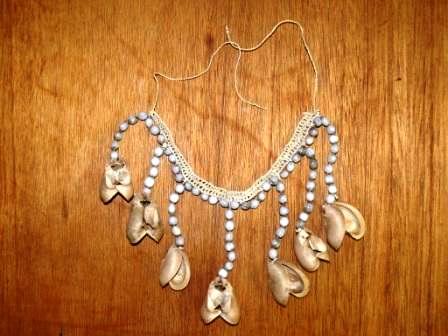 |
olla « canta » pot
Uso tradicional : Tradicionalmente usábamos las ollas cotidianamente . Cocinábamos la chicha, chucula, carnes y diferentes comidas en las ollas grandes. Usábamos las ollas pequeñas para poner agua caliente y metíamos el pelo para que crezca pelo largo y no parta el pelo.
Traditional use : Traditionally we used the pots for daily use. We used the large pots to cook chicha, chucula (a warm plátano drink), meats and other foods. The small pots were also used to soak our hair so that it grows to be long and healthy.
« »
Elaboración : Tenemos vasijas y ollas de formas exclusivas. La cerámica Waorani es hecha a mano, no tiene pinturas ni decoraciones. Las hay de diferentes tamaños, las mas grandes de 60 cm de alto por 40 cm de ancho tienen una capacidad de 25 litros. Para cocer la cerámica utilizamos madera de chonta, guadua u otra. Alrededor de la vasija colocan la leña parada y la dejan quemar hasta que se consuma todo.
Production : Our ceramic pots and containers are unique. Waorani ceramics are made by hand and do not have any paint or decorations. There are many different sizes, the biggest are 60 cm high by 40 cm wide and can hold up to 25 liters. We use chonta or guadua wood in order to bake the ceramics. Around the ceramics we place stacked wood which we let burn until it is finished. |
|
| |
 |
brazalete « tinta » armband
Uso tradicional : Antiguamente, amarrábamos los brazaletes en los dos brazos durante las fiestas, y ahora los consideramos como parte de ropa típica.
Traditional use : Historically we tied the armbands on both arms for parties and now we consider them part of our tipical dress.
« »
Elaboración : Usamos algodón de la selva y a veces chambira para elaborar los brazaletes. Primero, amarramos la piola en filas entre dos palos. Luego pasamos un palo pequeño abajo y arriba de las filas colgadas y después pasamos la piola. Los adornamos con plumas de guacamayos, tucanes y rabos de los monos.
Production : We use wild cotton and sometimes chambira to make the armbands. First, we tie the handmade string between two sticks, making rows. Then we pass a small stick over and under each row before threading the string through. We decorate the armbands with feathers from macaws, tucans and hair from monkey tails. |
|
| |
 |
hamaca « ño » hammock
Uso tradicional : Nosotros dormimos en hamacas, y también en ellas realizan las tareas cotidianas. Las hamacas se ubican junto al fogón y son el centro de la vida en familia. Generalmente cada una es suficientemente grande para acomodar hasta a cinco miembros de la familia.
Traditional use : We sleep in hammocks and also sit in them to conduct our daily work. The hammocks are located near the kitchen fire and are the center of family life. Generally, each hammock is big enough to accommodate up to five members of the family.
« »
Elaboración : Usamos las hojas tiernas de chambira (Astrocaryum chambira) que recogemos de la selva para crear hilo grueso para tejer la hamaca. La elaboración toma hasta tres meses.
Production : We use the new leaves from the chambira palm (Astrocaryum chambira) collected from the forest to create thick palm string . We then use the string to hand weave our hammocks. It can take up to three months to make one hammock.
|
|
| |
 |
| Look at the Waorani Women's Workshop page to see pictures of the women making the handicrafts. |
|
| |
 |
collar « baga » necklace
Uso tradicional : Collares auténticos Waorani muestran algunos rasgos fundamentales de nuestro pueblo. Tradicionalmente, nos poníamos los collares para las fiestas. Collares con muchos dientes de animales significaban que el hombre era un buen cazador. Ahora elaboramos collares de muchos estilos para uso cotidiana.
Traditional use : Authentic Waorani necklaces display the fundamental characteristics of our people. Traditionally, we would wear necklaces for celebrations. Necklaces with many animal teeth signified that the man wearing it was a good hunter. Now we make necklaces in many different styles for daily wear.
« »
Elaboración : El base de casi cada collar es una cinta tejida de chambira, fibra natural del bosque amazónico. Los collares elaborados tienen semillas, pepas y dientes grandes de algún animal cazado.
Production : The base of almost every Waorani necklace is a ribbon of woven chambira, natural material from the Amazon rainforest. The more elaborate necklaces feature colorful seeds and teeth from animals we have hunted. |
|
| |
 |
lanza « tapa » spear
Uso tradicional : Las lanzas de cacería no llevan adornos, y con ellas se cazan animales grandes. Las lanzas de guerra, en cambio, se adornan con plumas de aves, y su longitud puede ser hasta de tres metros.
Traditional use : Hunting spears traditionally have no decorations, whereas the spears used during war are adorned with colorful bird feathers and can be up to three meters in length.
« »
Elaboración : Usamos palos de pambil, uno de los tipos de madera mas fuerte en la selva para elaborar nuestras lanzas. La manufactura de instrumentos de cacería es y era una actividad exclusiva de los hombres Waorani.
Production : We use pambil, one of the strongest woods in the rainforest, to make our spears. The manufacture of hunting tools is and was an activity exclusively for Waorani men.
|
|
| |
 |
canasta « oyegunta » basket
Uso tradicional : En los canasta guardan la comida. Las cuelgan sobre el área del fogón para ahuyentar los moscos y conservar los alimentos.
Traditional use : Baskets are used to hold food. They are traditionally hung over the fire in order for the smoke to keep bugs away and to preserve the food.
« »
Elaboración : Para elaboración de una canasta, extraen los nervios de la palma de chambira y los colocan en el suelo en sentido vertical y horizontal luego los cruzan por arriba y por abajo. Los extremos sobrantes se tuercen hacia arriba y se amarran los bordes.
Production : To make the baskets, we extract the leaf veins of the chambira palm. We place them on the floor vertically and horizontally and then weave them under and over to make the basket. The extra material is then twisted to make the finished basket edge.
|
|
| |
 |
machete « yaeme » machete
Uso tradicional : Usábamos los machetes para limpiar la chacra y también para cortar bejuco y palitos para hacer leña. Antes de contacto con el mundo occidental, mujeres usaban los machetes para defensas en las guerras. Ahora elaboramos como arte etnico y adornos.
Traditional use : We used the machetes in order to clean and maintain the chacra (small farm or garden) and to cut vines and logs to make firewood. Before contact with the western world, Waorani women used the machetes defensively during the wars. Now we make them as ethnic art and for decorations.
« »
Elaboración : Los hombres elaboraban los machetes de chonta duro.
Production : Men make the machetes from chonta wood. |
|
| |
 |
red « geye odoitay » net
Uso tradicional : Usamos las redes para pescar en los ríos de nuestro territorio. Metemos las redes cuando se acaba de llover. Antiguamente poníamos una hoja (conyui) aplastada en el rió que era como un veneno para los pescados, para que naden a la superficie y los podemos coger en las redes fácilmente.
Traditional use : We use the nets to fish in the rivers of our territory. We put the nets in the river right after it stops raining. In ancient times, we would chop up a leaf (called conyui in our language wao terero) and put it in the water which served like a poison and caused the fish to swim to the surface, making them easier to capture in the nets.
« »
Elaboración : Las redes son hechas de chambira tejida, llevan alrededor un circulo de madera especial que es flexible y que se llama nenquiteago en wao terero .
Production : The nets are made of woven chambira which is then threaded with a circle of special flexible wood that we call nenquiteago in our language wao terero. |
|
| |
 |
If you would like to obtain one of these handcrafts,
and help the efforts of the Waorani
to protect their Amazon forest,
contact:
Save America's Forests
202-544-9219 9 |
|
| |
 |
|
|
| |
|







